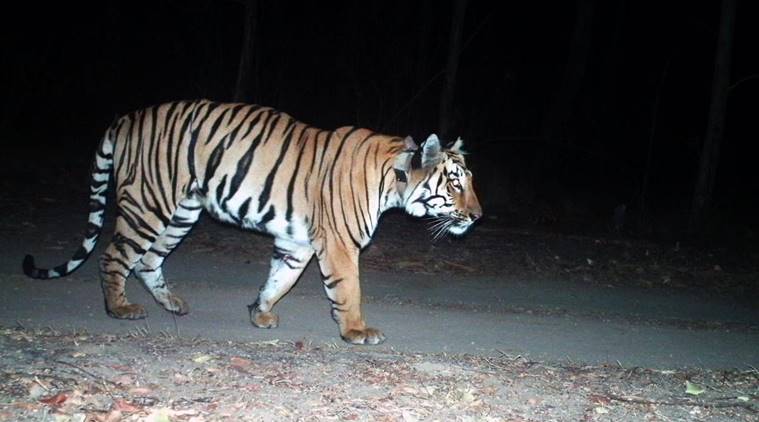- India
- International
This tiger becomes India’s ‘first’ ever to have walked nearly 1,700 km
What has baffled officials is the intent behind the extraordinary nomadic instinct of the tiger.
 Radio-collared sub-adult tiger, TWLS-T1-C1. (Source: Vivek Deshpande)
Radio-collared sub-adult tiger, TWLS-T1-C1. (Source: Vivek Deshpande)
The radio-collared sub-adult tiger, TWLS-T1-C1, from Tipeshwar Wildlife Sanctuary in Yavatmal district of Vidarbha, continues to evoke awe and curiosity about his seemingly unstoppable journey. Now, into the seventh month since he began in June, the tiger has logged nearly 1,700 km. This, incidentally, is the longest any tiger in India is known to have walked.
According to Pench Tiger Reserve (PTR) Field Director Ravikiran Govekar, who also looks after Tipeshwar Sanctuary, the tiger had travelled 1,500 km till his journey to Ajanta. After his return to Dnyanganga, it is estimated to have logged nearly 1,700 km.
A tiger is seen frequenting colonies close to the Chandrapur Super Thermal Power Station (CSTPS) in Maharashtra, creating panic among residents, who are demanding its capture | For full story click here https://t.co/AsCRDUejGY pic.twitter.com/1kEvAZi00G
As reported earlier, the journey hasn’t been linear but often back and forth across eight districts in Maharashtra and Telangana (Adilabad district). It has often moved into human-dominated landscapes. But besides one small incident of attack on a group of men in Hingoli district of Marathwada, that perhaps got too close for his comfort, the tiger hasn’t harmed anyone.
After remaining stable in the Dnyanganga Wildlife Sanctuary of Buldana for over two weeks, the tiger had started his journey further towards Ajanta Hills in Aurangabad district. After reaching there, it immediately started returning to Dnyanganga and, on Friday, he reached Dnyanganga again, officials said.
Incidentally, it was the first tiger to inhibit Dnyanganga.
“After travelling up to Soygaon beyond Ajanta Hills, the tiger had started moving back to Dnyanganga and reached there on Friday,” said Principal Chief Conservator of Forest (Wildlife) Nitin Kakodkar.

What has baffled officials is the intent behind the extraordinary nomadic instinct of the tiger.
“Tiger needs food, shelter and mate. He had often lodged himself in forest areas but didn’t remain there beyond 4-5 days. Along the way, he has also killed wild preys as well as cattle. In some of the areas that he had moved, like Dnyanganga, there were good hideouts as well as food. So, we thought this epic journey could be for a mate. But is that the real intent? We don’t know yet,” said Kakodkar.
He added: “If he would be looking for a mate, he could have further moved towards Muktainagar In Jalgaon distinct, where there are few but it preferred to return to Dnyanganga.”
Sector Wildlife Institute of India scientist Bilal Habib, who had radio-collated the tiger and is now monitoring its movement, said, “He is most likely searching for a female. It is likely there might have been some females in areas he has so far moved but those territories could already have been occupied by some dominant males. So, it is perhaps finding it difficult to get territory and mate both at one go.”
Habib hopes it would possibly now try a different route and head for Melghat Tiger Reserve, where it could finally get all that it needs.
Meanwhile, in another tiger straying episode, a tiger is seen frequenting colonies close to the Chandrapur Super Thermal Power Station (CSTPS), creating panic among residents, who are demanding its capture.
Kakodkar said, “I have asked officials to identify the animal since there is a tigress with four small cubs inside three CSTPS area that has a big prolapse thicket over hundreds of hectare. So, we need to be careful not to catch the wrong animal.
Honorary Wildlife Warden of Chandrapur Bandu Dhotre said, “There are at least two tigresses that are seen in the area. One is seen in Rashtrawadi Nagar locality close to CSTPS compound wall that has several breaches and the other is moving along the Irai river that has huge prolapse jungle on both sides. It is killing domestic cattle too and people have actually seen it. We are demanding that they are captured and relocated else it could potentially create huge trouble.”
“CSTPS has huge prosopis jungle that offers good hiding places and has thousands of stray cattle not owned by anyone. And it also has abundant water. So females find it ideal to raise cubs. To overcome this problem the prosopis jungle needs to be removed and breaches in the compound wall need to be plugged,” Dhotre said.
Last year, The Indian Express had reported how one of the four cubs of a tigress living in CSTPS had travelled over 500 km to Sarni Thermal Power Station in Madhya Pradesh killing at least two persons along the way before it was finally captured.
Must Read
Apr 19: Latest News
- 01
- 02
- 03
- 04
- 05





























